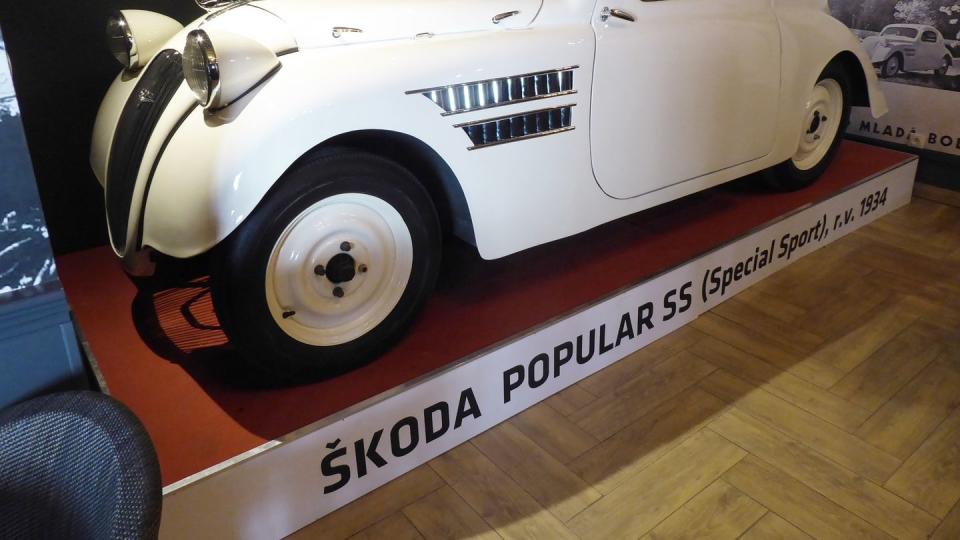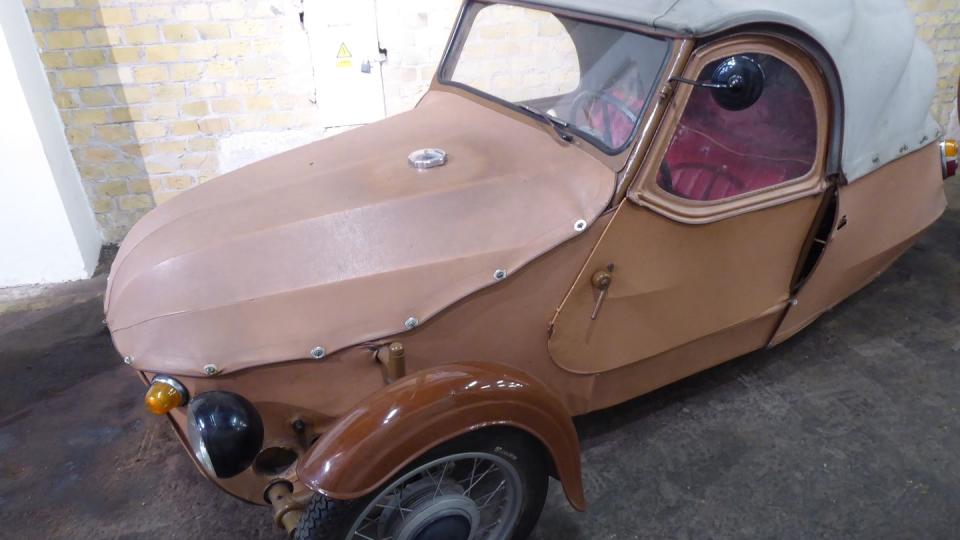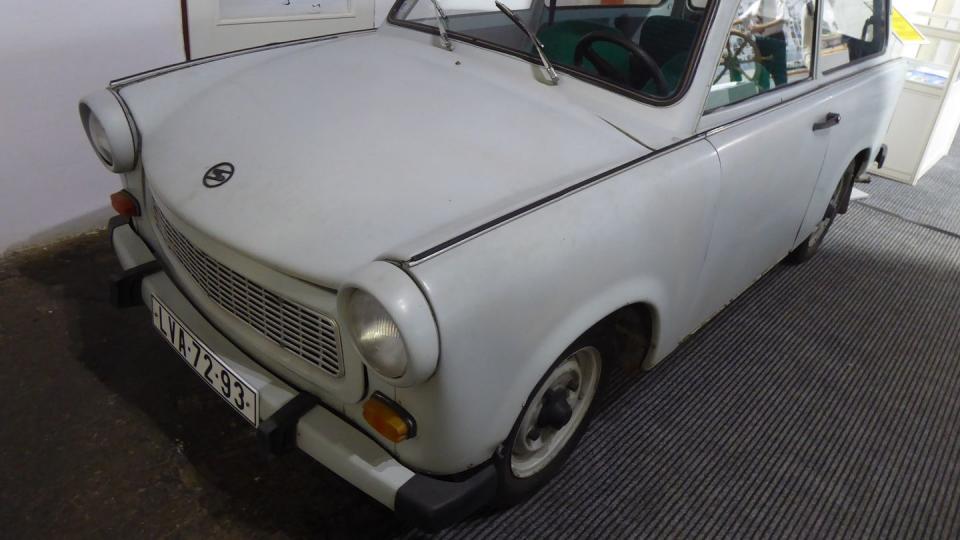Slovakia’s Czech-ered Automotive History

Slovakia’s Museum of Transport is appropriately located in Bratislava’s old steam railway station, and celebrates planes, trains and automobiles—quite a few of the latter, actually.
Visitors can go back to a period between the world wars when three Czech manufacturers, Tatra, Praga, and Škoda, all making small and affordable cars, were battling it out in the marketplace. (What was a united Czechoslovakia became the Czech Republic and Slovakia in 1992.)
A pretty little “American style” 1932 Praga Piccolo in two-tone gray and black was one of the most popular cars between the wars, and with 22 horsepower from a 1.5-liter four was capable of a heady 85 kilometers per hour.
Next to it was a wild and even more economical car, a flimsy looking Velorex 16/350 three-wheeler (two in front) with leatherette bodywork. The original market was disabled persons. Power came from a Jawa motorcycle engine of 16 horsepower. It could reach the same speed as the Piccolo, but any such attempt would be foolhardy.

How did that 1913 Buick get into the hall? Apparently, they were popular back then, and available in the right-hand drive that Czechoslovakia used at the time. The Buick was more or less contemporary with an ornate horse-drawn funeral carriage—in use until the 1970s.
The dramatic Tatras we know, with their rear-mounted V8s and streamlined styling, were preceded by more utilitarian vehicles such as the 1932 T57 Sport and 1929 12 taxi. The 57s came with water-cooled four-cylinder boxer engines and sported a backbone chassis and a driveshaft running in a central structural tube, an innovation that influenced other makers.
Just as cute as a bug was a bright red Aero 662 roadster with rumble seat. Squint, and it could be an MG-TD. It looked racy, but the engine was a two-cylinder, two-stroke water-cooled unit of just 662-cc and 18 horsepower. Getting to 50 miles per hour took 25 seconds. Sixty was probably not attainable.
Cars of the modern era included a green 1946 Škoda Tudor, the model that replaced the pre-war Popular—and was not a dramatic departure from it. These were sold in 70 countries between 1946 and 1952, and 66,000 were produced.
A 1969 Škoda 1000 MB was something else again, with modern boxy styling and a rear-mounted 44-horsepower engine of 988-cc driving the back wheels. These cars had some international impact, including selling well in Britain (where they were considered bargains) and were on the market from 1964 to 1969.

Of course, there was a plastic-bodied East German-made Trabant, in this case a 601 Kombi wagon. With heavily polluting two-cylinder, two-stroke engines they had all of 25 horsepower and were a symbol of mediocrity all across the communist bloc.
Zero to 62 took 21 seconds, so it was faster than an Aero 662. Trabants are virtually gone from Slovakian roads now. And just try to find the Soviet-era Lada 1200, a Fiat 124 knockoff made at Tagliotti in Russia.
Parked across from these reminders of the grim past, however, was more of a status symbol, a two-door Saab 90 coupe produced at Valmet in Finland and never imported into the U.S.
The example in the museum was bare-bones, fueled by a single carburetor, and semi-derelict. The styling combines the 99 and 900 models. If you want a 90, the one to get is known is the special edition “White Weasel,” with many luxury appointments—though no more power.

There were trucks and trains in profusion, and a large motorcycle and bicycle collection. The latter spoke to the era when most urban transportation was two-wheeled. There was even a flamboyant Orange County Chopper that somehow made it over to Slovakia.
The collector behind the Škoda Classic Cars Museum in Trenčin, Slovakia, has a singular passion—the company’s Popular model that spanned the Second World War. It was a cheap and cheerful car, launched in 1932 and available as two- and four-door sedans, roadsters, ambulances and vans.
The Popular used a backbone tube chassis with independent suspension that, interestingly, derived from the design of Hans Ledwinka’s groundbreaking Tatras (also Czech cars, with later versions serving as the inspiration for the Volkswagen Beetle).
The Popular was indeed popular, and catapulted Škoda from third to first place in the Czech marketplace by 1936 (ahead of Praga and Tatra itself), with a 39 percent market share.
The museum has just 11 cars, but they’re all pristine and mostly quite alluring in a vaguely cartoonish way. Some of the little roadsters have rumble seats and look pre-war even when they’re from 1951. Mr. Natural drove cars like this.
A prime example is a silver 1940 Škoda Popular 927 roadster, with a front-mounted one-liter water-cooled four producing all of 30 horsepower, connected to a three-speed floor shift with synchro on second and third. With a headwind, the rear-wheel drive car could reach 100 kilometers per hour. Some 6,600 were made.
Populars had independent front suspension, with a leaf spring, four-wheel cable brakes, and—several placards said—cost-saving considerations that dictated their “having to do without a differential.” Most had suicide doors, and right-hand drive until the later models.
Now let’s leap forward to 1951, and the first postwar Popular 1102. The new model sported ventilation flaps to distinguish it from 1940 models. The yellow example on exhibit was quite snazzy, and must have looked good to a population starved of civilian motor cars. It cost 68,000 crowns, which (possibly because demand was high) soon increased to 88,000.
You want something more upscale? The Rapid was introduced in 1934 as the middle-class version of the Popular. We’re still talking 26 horsepower, but they were durable. A Rapid went around the world in 97 days circa 1936, captained by Bretislav Prochazka.

You want competition? Now we come to the coolest of all Škoda Populars, a 1936 Popular Special Sport (SS) two-seater built for a Czechoslovakian 1000-kilometer competition in 1936 that never happened.
The cars looked the part, with streamlined bodywork that ended in a rounded art-deco tail (“flowing butt” the placard said) with a tiny oval rear window and a cute little fin. Only 17 of these cars were made between 1935 and 1936. The competition pretensions didn’t make much of an impression under the hood—a three-speed manual and 26 horsepower.
The height of Popular success on the track was a 1.5-liter class win at the Monte Carlo Rally in 1936. That led to the Popular Monte Carlo model, with Lockheed brakes and a 1.3-liter version of the engine as seen in the Rapid. King Peter of Yugoslavia had a two-door convertible version.
Škoda is still a thriving automaker, based in the adjoining Czech Republic, and it’s the most popular make on Slovakian roads. The competition is Hyundai, Kia, VW, Volvo, Mercedes, PSA Peugeot Citroën, Audi, and a bunch of Chinese brands, Dongfeng, MG, and others. Europe has cars from 20 Chinese automakers on sale.
Slovakia is also a car-making country, with factories that assemble Kia, Volkswagen, Peugeot and (under construction, with plans for EV production in 2026) Volvo. The country produced around a million cars in 2022.
There aren’t a lot of classic cars on Slovak roads, but Trenčin does house a Vintage Cars Gallery. It was closed on our visit, but visible inside were such beauties as a 1975 Morgan Plus 8 (with Sports Car Club of Scotland grille badging) and a 1987 Porsche 911 Carrera with 3.2-liter power. Many of the cars were California imports, including a 1969 Jaguar Series Two E-Type, a 1959 MGA, a 1952 MG-TD and a 1970 Mercedes-Benz 280SL that had been restored in Holland. There was also an unusual 1955 Mercedes 190 SLR in competition trim. Prices fit the international market. The E-Type could be yours for €164,000.

 Yahoo Autos
Yahoo Autos 